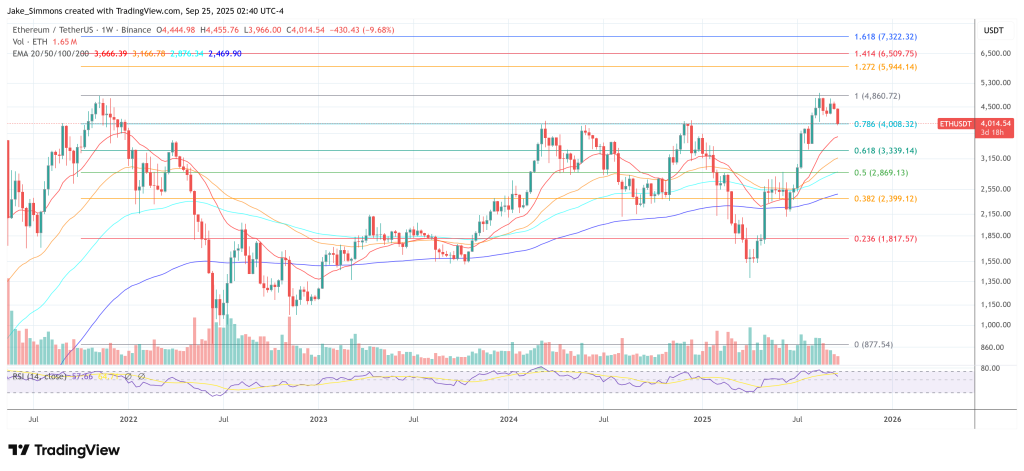Ethereum Thesis From Tom Lee Torched As ‘Retarded’ By VC Firm Boss


Mechanism Capital co-founder Andrew Kang escalated his critique of Tom Lee’s latest Ethereum investment case with an unusually blunt tirade on X, interlacing his rebuttal with a series of sharply worded assertions and data-driven claims. “Tom Lee’s ETH thesis is one of the most retarded combinations of financially illiterate arguments I’ve seen from a well known analyst in a while,” Kang wrote, before listing five pillars he says underpin Lee’s view: “(1) Stablecoin & RWA adoption; (2) Digital oil comparison; (3) Institutions will buy and stake ETH; (4) ETH will be equal to all financial infrastructure companies; (5) Technical analysis.”
Is Tom Lee’s Ethereum Thesis Retarded?
Kang’s central attack targets the idea that rising tokenization and stablecoin activity should translate into outsized fee capture for Ethereum. “Since 2020, tokenized asset value and stablecoin transaction volumes have increased 100–1000x… [but] fees are practically at the same level as in 2020,” he argued. He attributed the disconnect to “Ethereum network upgrades making tx’s more efficient,” activity moving “to other chains,” and the reality that “tokenizing low-velocity assets doesn’t drive much fees.” He distilled the point with a stark comparison: “Someone could tokenize a $100m bond and if it trades once every 2 years… A single USDT would generate more fees.”
The Mechanism Capital partner pushed the competitive angle further. “Most of the fees will be captured by other blockchains with stronger business development teams,” he wrote, naming “ Solana , Arbitrum, and Tempo” as seeing “most of the early big wins,” and adding that “Tether is supporting two new Tether chains, Plasma and Stable,” explicitly intended to route USDT volume to Tether-controlled rails.
Kang also dismissed Lee’s “digital oil” framing as analytically hollow. “Oil is a commodity… real oil prices adjusted for inflation have been trading in the same range for over a century with periodic spikes that revert… I agree ETH could be viewed as a commodity, but that’s not bullish,” he wrote.
He extended the range analogy directly to Ether’s chart: “Looking at this chart objectively, the strongest observation is that Ethereum is in a multi-year range… we recently tapped the top of the range, failing to break resistance… I would not discount the possibility of a much longer $1,000–$4,800 range.” On relative performance, he added: “Long-term ETH/BTC is indeed in a multi-year range, but the last few years have mostly been dictated by a downtrend… The ethereum narrative is saturated and fundamentals do not justify valuation growth.”
On institutions, Kang argued that Lee’s premise—that banks and large corporates will accumulate and stake ETH to secure tokenization networks or as operating capital—misunderstands treasury behavior and value accrual. “Have large banks… bought ETH on their balance sheet yet? No. Have any of them announced plans to? Also no… Do banks stock up on barrels of gasoline because they continually pay for energy? No… Do banks buy stocks of asset custodians they use? No,” he wrote, calling the idea that staking demand from incumbents would underpin valuation a category error.
Kang’s thread culminated in a withering assessment of Ethereum’s pricing dynamics: “Ethereum’s valuation comes primarily from financial illiteracy… [which] can create a decently large market cap… But the valuation that can be derived from financial illiteracy is not infinite… Unless there is major organizational change it is likely destined to indefinite underperformance.”
Lee’s latest outlook, by contrast, has emphasized Ethereum’s suitability for Wall Street tokenization and its role as a “neutral chain,” with public targets clustered around $10,000–$12,000 by end-2025 and up to $62,500 in a favorable super-cycle.
At publication time, ETH traded near $4,000.


Analyst Says Bitcoin Bear Market Has Started, Predicts 50% Crash To $61,000
After hitting its $124,000 all-time high back in July, the Bitcoin price has now moved back into a p...

Avalanche (AVAX) Price Holds Key Support, But Analyst Warns Rally Could Be At Risk
After a strong price performance over the past month, driven by growing interest in the Avalanche ec...
All-Time Highs For Gold, S&P500; Crypto Stands Alone In The Red – What’s The Root Cause?
Crypto markets have recently faced renewed challenges, despite a brief resurgence following the US F...

